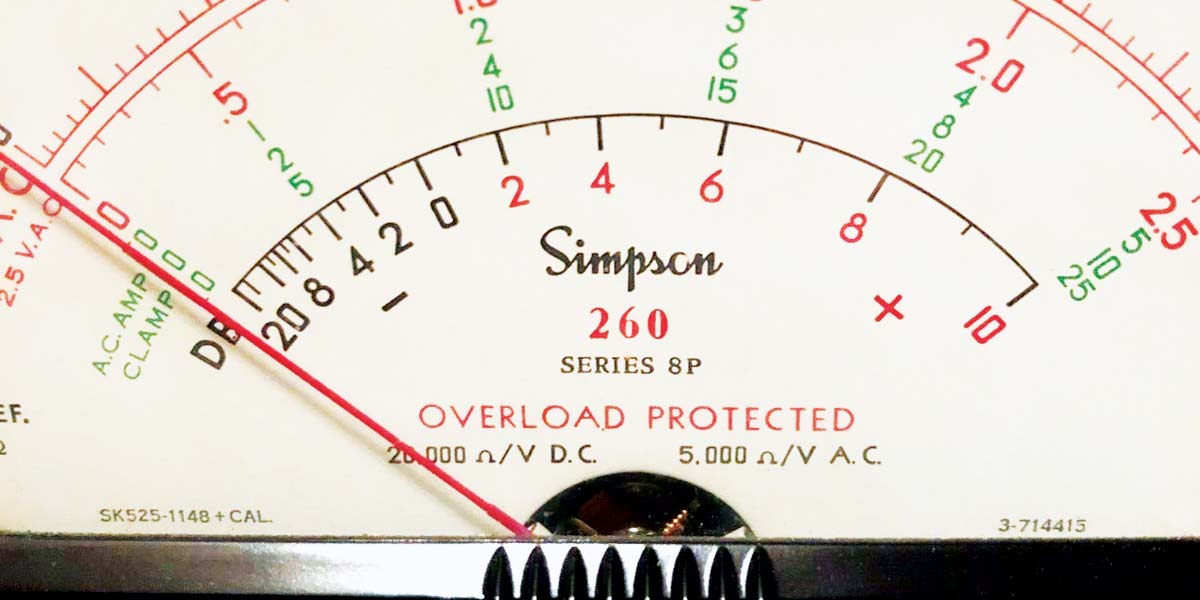
An Analog Artifact Worthy of Your Robotics Toolkit
By Bryan Bergeron View In Digital Edition
At my first real job with a communications company, every technician was equipped with a piece of state-of-the-art test gear designed to function in the harshest environments and with literally constant abuse. Of course, I’m talking about the Simpson 260, easily the most popular analog VOM (volt-ohm meter) of all time.
The best technicians and engineers wouldn’t consider anything else to assist them in diagnosing and maintaining microwave communications gear. I remember the best of the engineers could read a dozen values in only a few seconds. They could accurately estimate values long before the Simpson’s needle moved into final position, simply based on the initial velocity of the needle.
I, on the other hand, lusted after one of the new digital meters on the market. After all, why settle for a reading of only 2-3% full scale accuracy, when a DMM could theoretically take a reading with double the accuracy and to several digits and with a much higher input impedance?
Putting aside the issues of settling time, need for frequent calibration, and the need to be near a 110V outlet, when digital meters first hit the market, they were cool. They were like having one of the first iPhones to hit the street.
Over the years, I worked through several generations of DMMs, ranging from $10 to over $800. I even considered the digital Simpson — a short-lived abomination. My current toolkit includes a portable Fluke 87 DMM and a benchtop Fluke 45 DMM.
Other than changing batteries and leads, these DMMs have been trouble-free and a cornerstone of my repair work. So, why did I add a Simpson 260 to my arsenal, especially when — on specifications alone — a DMM with similar capabilities can be had for 5% of the price of a used Simpson 260?
I have to admit the reason is partly nostalgia. After all, handling the 3 lb over-sized Bakelite case and the solid “click-click” rotary switch is pure pleasure. Instead of a series of cold LED or LCD numbers, my measurements are based on a crisp black needle deflected across a colorful mirrored background.
My reason for acquiring the Simpson 260 (Simpson 260 8p, used, with leather case, $175, eBay) is also partly practical. Measuring the voltage across and current through motors and other actuators is simply easier with an analog meter. The analog meter movement is relatively immune to higher frequency noise and spurious signals, making measurements a lot easier.
In fact, I’ve found the Simpson performs well in just about every task previously covered by my Fluke DMMs. If I could talk with the Simpson designers, the only change I’d suggest is to supplement the current DCV full scale ranges of 2.5V, 10V, 25V, 50V, 250V, 500V, and 1000V with 3.5V and 5.0V or 6.0V. Even so, the 10V full scale range is sufficient for both 5V and 3.3V circuits.
If you’re convinced that an analog artifact is in your future, the cost of entry is between $50 and $200 used, depending on model and condition, and $350 new (Simpson 260-8p, Amazon).
A point to consider is that, unlike your digital meters and lesser analog VOMs, even an older Simpson is likely to outlast you. SV
Article Comments